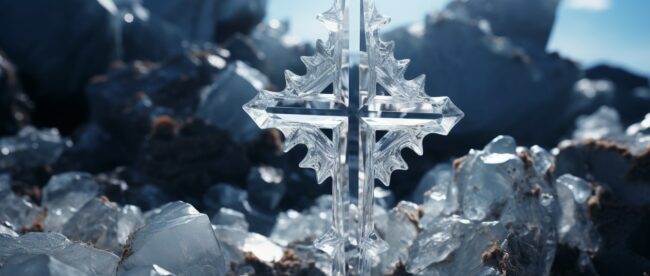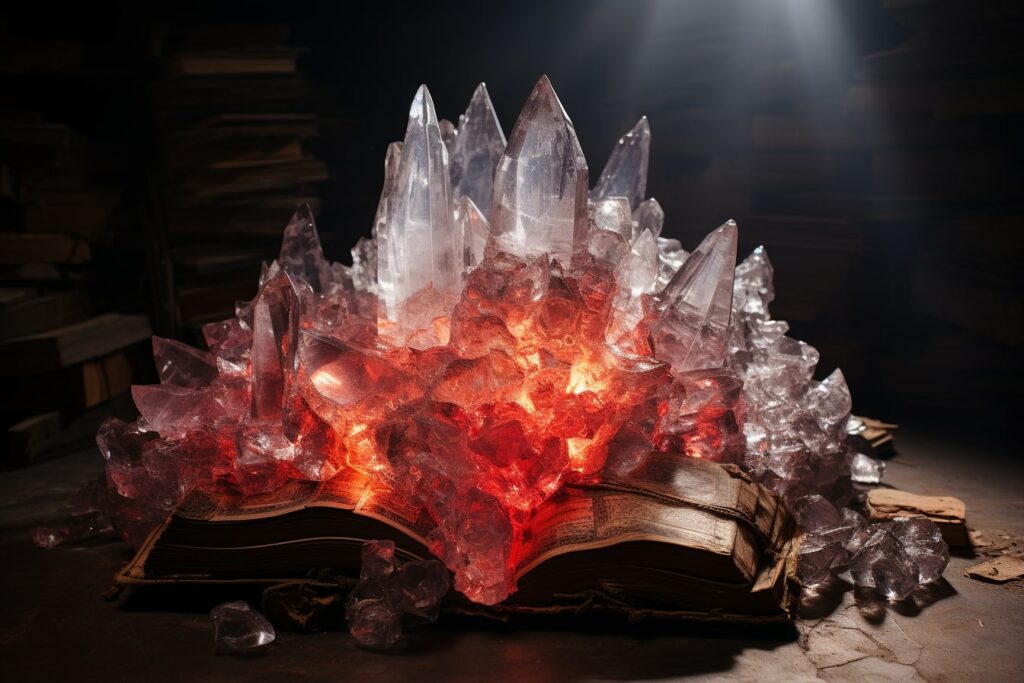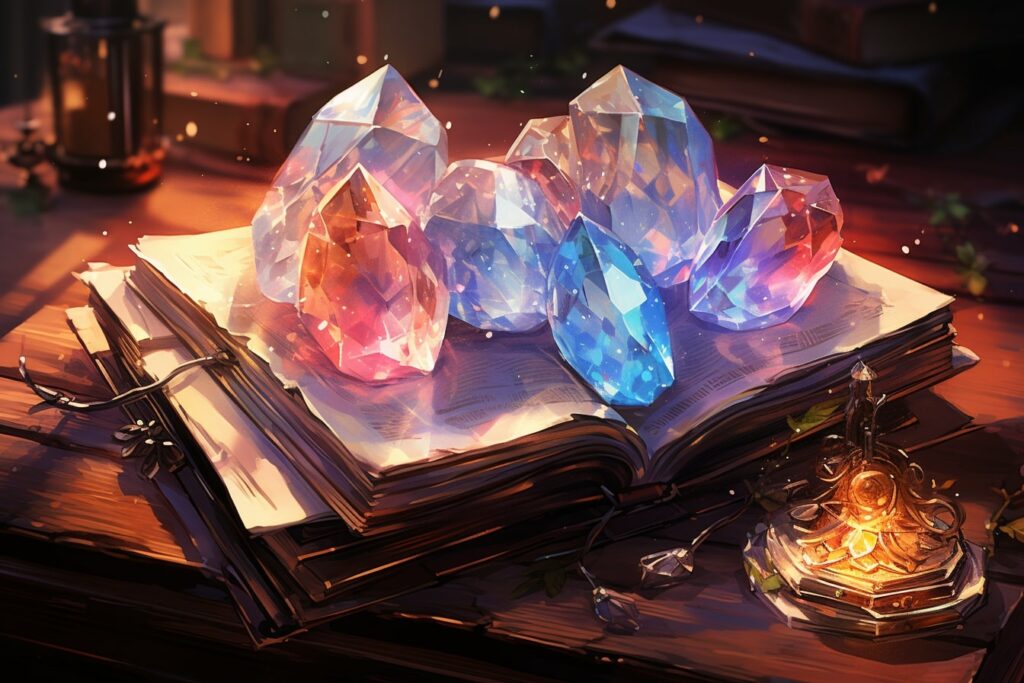What Does the Bible Say about Crystals?

Buckle up, my spiritual seekers! Crystals are having a moment in the sun (literally and figuratively) these days. With everyone from Instagram influencers to your yoga-loving neighbor raving about the healing powers of amethyst or the protective vibes of onyx, it’s hard not to get caught up in the crystal craze. But here’s a twist for you: What if I told you the Bible, that age-old book of spirituality, had some nuggets (pun intended) about our beloved crystals? That’s right! Let’s deep-dive into the intriguing connection between the good old Bible and our shimmering stones.
Do you have a specific question about Bible stance on crystals? Then use the table of contents below to jump to the most relevant section. And you can always go back by clicking on the black arrow in the right bottom corner of the page. Also, please note that some of the links in this article may be affiliate links. For more details, check the Disclosure section at the bottom of the page.
Here's what we'll cover:
Crystals in the Bible
You might raise an eyebrow, but the use of crystals isn’t just a “new age” concept. The Bible, believe it or not, has its fair share of crystal mentions. It isn’t exactly shouting from the rooftops about crystal healing, but there’s no denying that these glittering treasures made their mark in biblical times.
Examples of crystals and stones found in the Bible
Ready to be dazzled? The Bible isn’t shy when it comes to name-dropping some of our favorite stones:
- Exodus mentions the breastplate worn by the Levitical high priest contained twelve stones, each representing a tribe of Israel. We’ve got emerald, topaz, and jasper in the first row, sapphire, agate, and amethyst in the second row, lapis lazuli, jacinth, and beryl in the third row, and onyx, jacinth (again, it’s just that fabulous), and carnelian in the fourth row.
- Ezekiel mentions topaz, beryl, and jasper, among others.
- Revelation paints a vivid picture of heaven, mentioning jasper, sapphire, chalcedony, emerald, sardonyx, chrysolite, beryl, topaz, chrysoprase, jacinth, and amethyst.
Significance of crystals and stones in the Bible
In biblical times, stones and crystals were so much more than just decorative elements. The Levitical high priest’s breastplate, for example, was designed not just with aesthetics in mind, but as a sacred artifact. The stones on this breastplate held a deeper significance. Whether for protection, healing, or representing the twelve tribes, each stone was chosen with intention and purpose.

What does the Bible say about crystals in heaven?
Imagine a place clear as crystal, where the area before the throne is something like “a sea of glass.” Revelation paints a vibrant picture of heaven where different crystals emanate good vibrations, bringing beauty and splendor to the divine realm. These mentions are perfect examples of God’s handiwork, where every shimmer and shine is created by God.
What does the word crystal mean in the Bible?
When the Bible mentions “crystal,” it’s often referencing clarity and purity. Picture it: a sea in heaven “clear as crystal.” It’s a symbol of transparency, divine purity, and unblemished beauty. But, and here’s where it gets tricky, while the Bible lauds the beauty of crystals, it doesn’t exactly endorse the use of crystals for healing or divination. In fact, Deuteronomy warns strongly against engaging in anything related to superstition, witchcraft, or sorcery. The Bible mentions that true healing can only come from the Lord, and turning to crystals for healing powers might make you guilty of idolatry.
In a world where crystals offer so much – from aligning body’s chakras to promoting peace – it’s fascinating to see their historical and spiritual significance in the Bible. Whether you’re donning an amethyst for tranquility or reading about the jasper walls in heaven, always remember to seek a balanced path of enlightenment and spirituality.
Crystals and New Age Practices
Fast forward to today, and many believe that crystals have healing properties. They’re used to bring good luck, for protection or healing, and even to stimulate spiritual growth. While the Bible never explicitly states that these stones held the same kind of ‘magic’ as today’s crystal enthusiasts believe, it does provide guidance on the use of various elements for specific purposes. The Bible never directly promotes or condemns the use of crystals for healing or protection. But, here’s the twist: the bible warns against replacing God with something other than God. If a crystal becomes an idol, it’s a no-no.
What are some New Age practices involving crystals?
New Age practices involving crystals span a wide spectrum. From meditation enhancers to dream catalysts, crystals have taken center stage in modern spiritual rituals. Some folks use them to declare positive intentions, while others believe in their capacity to turn away negative energies. There’s also the practice of placing crystals on various body parts, aiming to align chakras and restore balance. But here’s where things get tricky: the bible warns strongly against engaging in magic arts or anything that may detract from the worship of God.
What does the Bible say about these New Age practices?

Now, for the meaty part. The Bible is pretty clear when it comes to practices that could be considered ‘New Age.’ In Deuteronomy, the scripture goes something like “let no one be found among you who practices divination or sorcery, interprets omens, engages in witchcraft, or casts spells, or who is a medium or spiritist or who consults the dead. Anyone who does these things is detestable to the Lord your God.” Yikes, right?
In Acts, there’s also a scene where new believers “brought their books together and burned them publicly,” and the value of these was estimated at fifty thousand pieces of silver. This dramatic act was to show their rejection of practices which were forbidden in the bible.
While the Bible appreciates the beauty of crystals (remember that something like “a sea of glass” in Revelation?), it is essential to note that crystals cannot replace God’s power and blessings. God can provide what we need, and relying on anything else, even if it’s a shimmering, hand-polished gem, might just be treading on thin ice.
Are Crystals Demonic?
Dive deep into the Bible, and you’ll find many mentions of gemstones. It’s not just about a “sea of glass” or “pure gold”. Think about the dazzling twelve foundation stones in the New Jerusalem, described in the Book of Revelation, including the second sapphire, third chalcedony, fourth emerald, fifth sardonyx, seventh chrysolite, eighth beryl, ninth topaz, tenth chrysoprase, eleventh jacinth, and twelfth amethyst. But does that mean the early church practiced magic with them? Not really. The Bible doesn’t declare the practice of using crystals for spiritual or healing purposes, and it doesn’t necessarily associate them directly with the occult. However, context is key!
Why should Christians avoid using crystals?
1. They are a form of idolatry
The Bible cautions against putting anything above God. Remember the golden calf? In similar ways, many in the new age spirituality realm use crystals as more than just pretty stones. They believe these stones hold power. But if we’re seeking spiritual power outside of God’s grace, aren’t we straying into a territory the early church warned us about?
2. They offer false hope
While it’s tempting to believe that a certain amethyst or topaz can bring peace, prosperity, or love into our lives, true hope is found in faith. In life’s stormy times, it’s essential to anchor our hope in something unshakable, like a relationship with God, rather than the shifting sands of the latest spiritual trend.
3. They can be dangerous
Not in the “they might fall on your toe” kind of way, but spiritually. The occult has often mixed crystals into its practices. While not every crystal bearer is summoning the dark arts, it’s still a slippery slope. Play it safe; you wouldn’t want to accidentally tap into energies or entities you weren’t bargaining for.
4. They are a waste of money
Crystals, especially the rare ones, can come with hefty price tags. Could that money be better spent elsewhere? Maybe on something that directly benefits your spiritual growth or aids others in need?
5. They take the focus off of God
This is perhaps the most significant reason. If we’re so concerned with cleansing, charging, and programming our latest chrysoprase or sardonyx, where does God fit into our daily routine? Our attention should be on the divine, not the divine-looking stones.
Final Thoughts
The Bible does talk about beautiful gemstones. From mentions of “pure gold” to the “sea of glass,” these stones play a symbolic role in the holy text. But never are they seen as tools to replace or amplify one’s relationship with God. As with everything, moderation and understanding are vital. Seek knowledge, ask questions, and remember – your connection with the Divine is more valuable than any gem on Earth.
Thanks for the blog graphics: Canva.com
Disclosure: At Quartwhisper.com we only mention the products that we’ve researched and considered worthy. But it’s important to note that we are a participant of several affiliate programs, including but not limited to VigLink and Amazon Services LLC Associates Program, an affiliate advertising program designed to provide a mean for us to earn fees by linking to Amazon.com and affiliated sites. As an Amazon Associate Buddhatooth.com earns from qualifying purchases.
